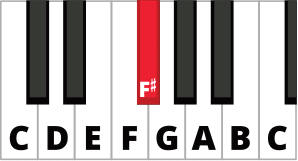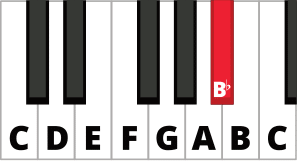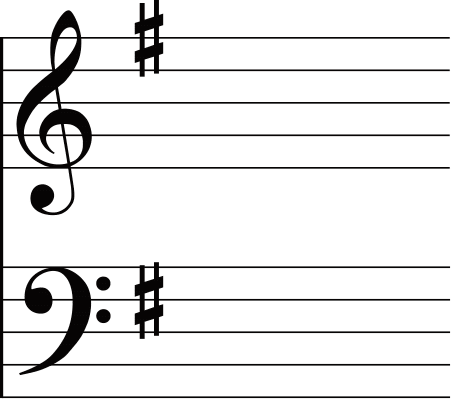One of our most popular lessons is on how to read music notes on the piano.
It’s a great introduction to musical notation, and if you’ve been struggling with reading music, it will really help simplify the whole thing.
But there’s a common question I get about that lesson…
“What about sharps and flats?”
These symbols are called “accidentals” and they can be confusing if you don’t know what they mean. But once you know … they’re not so scary anymore.
I like to call sharps “the original hashtag”. When you see them, you’ll understand why:

Sharps are much older than hashtags though. A sharp is usually written in front of a note, and it simply means that you need to raise that note by a half-step.
In the example below, there are 2 F notes. The first is a regular F, and the second is F# (F-Sharp). Notice how the sharp is placed directly in front of the F:

When it comes time to play that note, you’ll raise F by a half-step, and play F#:

The important thing to remember is that whenever you see a sharp symbol you just raise that note by a half-step, whatever the note is.
The other common symbol you’ll see in music is the flat, which looks a little like a squished-up “b”:

Just like how a sharp RAISES a note by a half-step, a flat LOWERS a note by a half step. It’s also written directly in front of the note. Here’s Bb as an example:

When it comes to playing that note on the keys, you’ll lower the B by a half-step to play this:

I find it helpful to think about a flat-tire to remind me that flats LOWER the note.
Up until now, these symbols have all been written directly in front of the notes they apply to. When this is the case, the symbols are called “accidentals”. But they’re not always written this way.
Sharps and flats can be written at the start of a piece of music…
Sharps and flats most often appear in key signatures. This means they’re written on the staff at the beginning of a piece of music, and they apply to EVERY note on which they’re written in the whole song.
To help explain, let’s look at a key signature. Here’s the key of G major written on the Grand Staff:

You can see the sharp symbol is written on the F lines in both the treble and bass clef. This means that EVERY SINGLE time you see an F in this piece of music, it’s an F sharp.
This can be confusing for beginners and it’s easy to forget, so I find it helpful to go through a piece of music and circle all the notes that are affected by a sharp of a flat in the key signature.
Let’s quickly recap. Sharps raise a note by a half-step. Flats lower a note by a half step.
But there’s one more symbol that we need to talk about…
What if you want to cancel a sharp of a flat? That’s where you need a natural. Naturals return a note to their “natural”, unaltered state.
It looks like this:

So where would you expect to find a natural? They are most often used to alter notes that have been affected by key signatures. Take a look at the example below:

You can see that this piece of music has an F# in the key signature. Remember that means EVERY F that you see will be raised by one half-step. So the 1st F in this line is an F#.
But the composer wants the 2nd F to be just a regular F note, so there is a natural in front of the F to return it to the white key.
Naturals can cancel out both sharps AND flats. The easiest way to think about it is if you see a natural in front of a note — just play the note that’s written!
That’s a basic rundown on the most common symbols you can expect to find in music. If you have questions about any other symbols you’ve seen just comment below and I’ll answer them!
Have fun!
Lisa Witt has been teaching piano for more than 20 years and in that time has helped hundreds of students learn to play the songs they love. Lisa received classical piano training through the Royal Conservatory of Music, but she has since embraced popular music and playing by ear in order to accompany herself and others. Learn more about Lisa.
/marketing/pianote/promos/april/banner-bg-m.webp)
We use cookies for traffic data and advertising. Cookie Policy »
/marketing/pianote/promos/april/banner-title.webp)